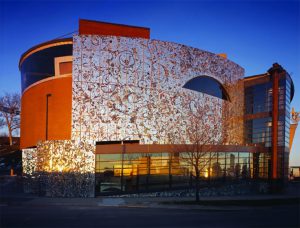
I recall co-worker Dustin Carlson taking the scissor lift high as he steadied another heavy mosaic panel glinting in Baltimore’s inner harbor morning sun. A flash reflected across the embedded cut mirrors, cobalt blue bottles, and bits of multi-colored stained glass. The co-director of this project, my friend Beth Secor, and I watched as Dustin carefully lifted and secured the panel on the curvilinear cement surface of the American Visionary Arts Museum, known as AVAM. Whew! Another section up —hundreds to go to cover that three-story high front wall. Finishing that project was like building the pyramids, except the primary workers were dedicated teenagers, students from nearby Southern High (now Digital Harbor). Covering that massive wall took a few years of working throughout all seasons. We were there because the founder of AVAM, Rebecca Hoffberger, decided we should be. In 2001, after I had worked at the museum as an art handler helping mount exhibitions, Rebecca asked me to be the lead artist, alongside Beth, on the long-considered project, even though I had no mosaic experience. I agreed. Once Beth and I figured out the design, I drew the foundational drawings in black marker across each series of panels as we went. We learned with our team how to efficiently create detailed work one panel at a time atop the drawings. After completing the first front wall section, I left to join another collaborative to develop a Baltimore-based art magazineLater, a different crew led by artist Mari Gardner took over to finish the other walls.
Today, the mosaic wall, which now surrounds the entire museum at AVAM, is a tourist destination. I see people gathering before the reflective entrance wall and snapping photos whenever I visit. Last time, it was an entire Indian wedding party dressed in gorgeous traditional clothes. The photographer knew the location. It’s a tricky shoot due to the reflective surface. Another time recently, a group of flash college-age kids mugged for selfies using the mirrored backdrop. Children love to see their fractured reflection. Baltimore City kids fly up on their bikes and flit away. The wall represents the potential for freedom from norms; it shrugs off the modernity of the original building design for a glittery, highly decorated cosmic alternative. People still marvel at the tons of reclaimed mirrors (all from local glass stores) cut into swirls. And the many bins of recycled bottles reclaimed from a nearby shutdown factory that produced the original Noxzema bottles. As far as I know, no one has ever tried to damage or deface the wall.
Everyone working at AVAM participated, including the guards and office staff. The many dedicated college interns we were able to hire were vital. We were a team. Back then, the harbor was still wide open across the street, and you could see Fells Point. Today, the waterfront has been filled in with tall fancy apartments, and nearby Federal Hill is fully gentrified.
While there is a short mention online at the AVAM website(https://www.avam.org/art/leroy-e.-hoffberger-shining-youth%2Fshining-walls-mosaics), there is no long history or plaque about the wall on the actual site (now dedicated to LeRoy E. Hoffberger, Rebecca’s late husband and the museum’s co-founder). I wanted that, but it didn’t happen. I wanted it, not for me, but to recognize the many young people who worked on the project. They were 16-18 and attending a tough, barely functional public school in transition. The school had a dropout rate of over 90 percent. The students we worked with, mostly seniors, were the ones who stuck it out—trying for a better future in a world stacked against them. They struggled in life as all young people do and confided in us as they, too, became part of the museum family. Those student workers are the heroes of this story, and like many heroes, we don’t have their names. I imagine them today coming by as “forty-somethings,” finding the panels they worked on, still proud, maybe showing their kids the treasures we let them bury in the wall surface, a plethora of trinkets that you may discover if you look close.
Written by Jack Livingston
Photo credit: American Visionary Art Museum
